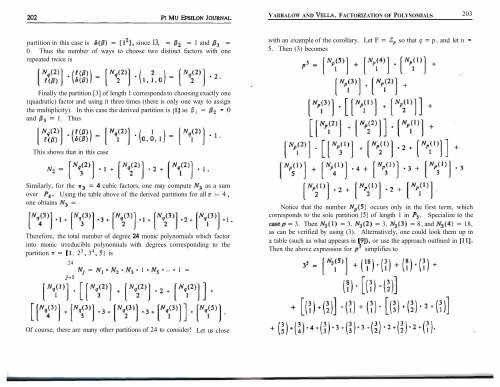Vol. 10 No 3 - Pi Mu Epsilon
Vol. 10 No 3 - Pi Mu Epsilon
Vol. 10 No 3 - Pi Mu Epsilon
- No tags were found...
Create successful ePaper yourself
Turn your PDF publications into a flip-book with our unique Google optimized e-Paper software.
VARBALOW AND VELLA, FACTORIZATION OF POLYNOMIALS 203partition in this case is 6((3) = [ 12], since 13, = P2 = 1 and O3 =0. Thus the number of ways to choose two distinct factors with onerepeated twice iswith an example of the corollary. Let F = Z so that q = p, and let n =5. Then (3) becomesFinally the partition [3] of length 1 corresponds to choosing exactly one(quadratic) factor and using it three times (there is only one way to assignthe multiplicity). In this case the derived partition is [I] as (3, = fS2 = 0and fS3 = 1. ThusThis shows that in this caseSimilarly, for the 5 = 4 cubic factors, one may compute N3 as a sumover PA. Using the table above of the derived partitions for all T t- 4 ,one obtains N3 =Therefore, the total number of degree 24 monic polynomials which factorinto monic irreducible polynomials with degrees corresponding to thepartition v = [l, 23 , 34, 51 is24j= 1Nj = N, *N2*N3- 1 *N5*-* 1 =<strong>No</strong>tice that the number Np(5) occurs only in the first term, whichcorresponds to the sole partition [5] of length 1 in P5. Specialize to thecasep = 3. Then N3(l) = 3, N3(2) = 3, N3(3) = 8, and N3(4) = 18,as can be verified by using (3). Alternatively, one could look them up ina table (such as what appears in [9]), or use the approach outlined in [I I].Then the above expression for o5 simplifies toOf course, there are many other partitions of 24 to consider! Let us close
















